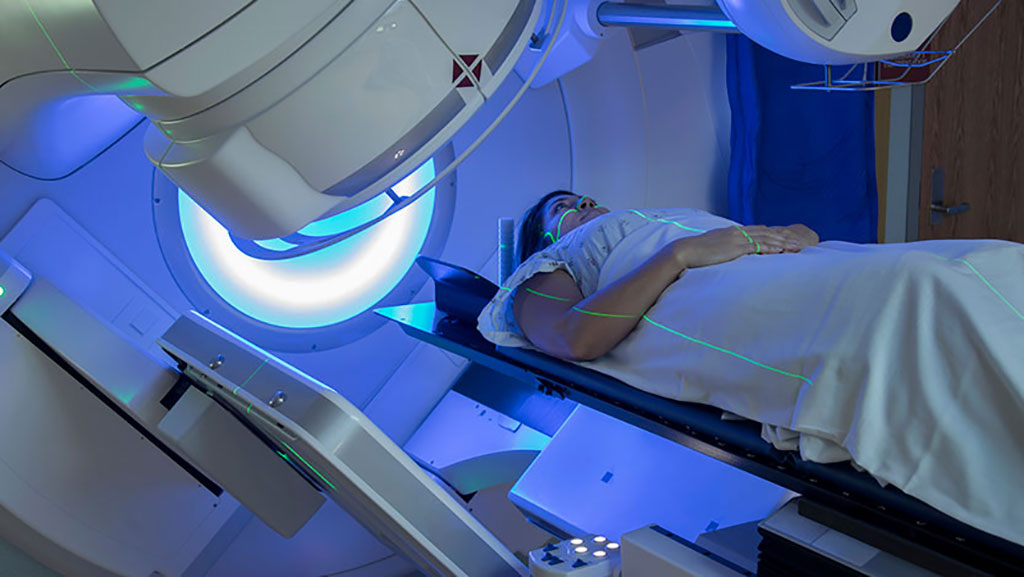SBRT Can Safely Treat Multiple Metastatic Tumors
|
By MedImaging International staff writers Posted on 03 May 2021 |

Image: SBRT can be used to treat multiple metastases (Photo courtesy of University of Chicago)
A new study suggests that stereotactic body radiotherapy (SBRT) can be used effectively for treating patients with multiple metastases.
Researchers at Fox Chase Cancer Center (Philadelphia, PA, USA), the University of Chicago Comprehensive Cancer Center (IL, USA), the University of Michigan (U-M; Ann Arbor, USA), and other institutions conducted a study involving 39 patients (mean age, 63.1; 20 57.1% male; 85.7% White) with breast, prostate, or non-small cell lung cancer (NSCLC), with at least three metastases or two metastases in close proximity. In all, 34.3% had breast cancer, 28.6% had NSCLC, and 37.1% had prostate cancer.
Dose levels were considered safe if dose-limiting toxicity (DLT) levels were observed in no more than one of six patients per location; otherwise, the dose at that location would be de-escalated. The primary end point was DLT related to SBRT within 180 days of treatment. Results of the phase one study showed that at the end of the trial period, primary six-month DLT endpoint was 0%, indicating that the approach was safe enough to begin phase 2/3 clinical trials in a larger group of patients. The study was published on April 22, 2021, in JAMA Oncology.
“People have been saying for years that if we used SBRT in patients with multiple, limited metastases, we could potentially cure more patients. But it's very technically complicated to do so,” said lead author Professor Steven Chmura, MD, PhD, of the University of Chicago. “The greatest challenge was having a whole team of people come together and figure out how we could define the doses and manage the real-time quality assurance to make sure every single patient had the best treatment possible.”
SBRT is emerging as an attractive option for treating cancers in the lung, head and neck, prostate, liver and other disease sites, with the objective of increasing local control of the target lesion while limiting dose to nearby critical structures and normal tissue. Requirements include precise localization of the target lesion in the treatment planning process; accounting for tumor motion due to respiration or other changes in the body; highly conformal dose distribution to the target volume, including a steep dose gradient to minimize radiation to surrounding healthy tissue; and image-guidance at the time of dose delivery for verification and adjustment of the target localization.
Related Links:
Fox Chase Cancer Center
University of Chicago Comprehensive Cancer Center
University of Michigan
Researchers at Fox Chase Cancer Center (Philadelphia, PA, USA), the University of Chicago Comprehensive Cancer Center (IL, USA), the University of Michigan (U-M; Ann Arbor, USA), and other institutions conducted a study involving 39 patients (mean age, 63.1; 20 57.1% male; 85.7% White) with breast, prostate, or non-small cell lung cancer (NSCLC), with at least three metastases or two metastases in close proximity. In all, 34.3% had breast cancer, 28.6% had NSCLC, and 37.1% had prostate cancer.
Dose levels were considered safe if dose-limiting toxicity (DLT) levels were observed in no more than one of six patients per location; otherwise, the dose at that location would be de-escalated. The primary end point was DLT related to SBRT within 180 days of treatment. Results of the phase one study showed that at the end of the trial period, primary six-month DLT endpoint was 0%, indicating that the approach was safe enough to begin phase 2/3 clinical trials in a larger group of patients. The study was published on April 22, 2021, in JAMA Oncology.
“People have been saying for years that if we used SBRT in patients with multiple, limited metastases, we could potentially cure more patients. But it's very technically complicated to do so,” said lead author Professor Steven Chmura, MD, PhD, of the University of Chicago. “The greatest challenge was having a whole team of people come together and figure out how we could define the doses and manage the real-time quality assurance to make sure every single patient had the best treatment possible.”
SBRT is emerging as an attractive option for treating cancers in the lung, head and neck, prostate, liver and other disease sites, with the objective of increasing local control of the target lesion while limiting dose to nearby critical structures and normal tissue. Requirements include precise localization of the target lesion in the treatment planning process; accounting for tumor motion due to respiration or other changes in the body; highly conformal dose distribution to the target volume, including a steep dose gradient to minimize radiation to surrounding healthy tissue; and image-guidance at the time of dose delivery for verification and adjustment of the target localization.
Related Links:
Fox Chase Cancer Center
University of Chicago Comprehensive Cancer Center
University of Michigan
Latest Nuclear Medicine News
- PET Imaging of Inflammation Predicts Recovery and Guides Therapy After Heart Attack
- Radiotheranostic Approach Detects, Kills and Reprograms Aggressive Cancers
- New Imaging Solution Improves Survival for Patients with Recurring Prostate Cancer
- PET Tracer Enables Same-Day Imaging of Triple-Negative Breast and Urothelial Cancers
- New Camera Sees Inside Human Body for Enhanced Scanning and Diagnosis
- Novel Bacteria-Specific PET Imaging Approach Detects Hard-To-Diagnose Lung Infections
- New Imaging Approach Could Reduce Need for Biopsies to Monitor Prostate Cancer
- Novel Radiolabeled Antibody Improves Diagnosis and Treatment of Solid Tumors
- Novel PET Imaging Approach Offers Never-Before-Seen View of Neuroinflammation
- Novel Radiotracer Identifies Biomarker for Triple-Negative Breast Cancer
- Innovative PET Imaging Technique to Help Diagnose Neurodegeneration
- New Molecular Imaging Test to Improve Lung Cancer Diagnosis
- Novel PET Technique Visualizes Spinal Cord Injuries to Predict Recovery
- Next-Gen Tau Radiotracers Outperform FDA-Approved Imaging Agents in Detecting Alzheimer’s
- Breakthrough Method Detects Inflammation in Body Using PET Imaging
- Advanced Imaging Reveals Hidden Metastases in High-Risk Prostate Cancer Patients
Channels
Radiography
view channel
AI Detects Early Signs of Aging from Chest X-Rays
Chronological age does not always reflect how fast the body is truly aging, and current biological age tests often rely on DNA-based markers that may miss early organ-level decline. Detecting subtle, age-related... Read more
X-Ray Breakthrough Captures Three Image-Contrast Types in Single Shot
Detecting early-stage cancer or subtle changes deep inside tissues has long challenged conventional X-ray systems, which rely only on how structures absorb radiation. This limitation keeps many microstructural... Read moreMRI
view channel
Novel Imaging Approach to Improve Treatment for Spinal Cord Injuries
Vascular dysfunction in the spinal cord contributes to multiple neurological conditions, including traumatic injuries and degenerative cervical myelopathy, where reduced blood flow can lead to progressive... Read more
AI-Assisted Model Enhances MRI Heart Scans
A cardiac MRI can reveal critical information about the heart’s function and any abnormalities, but traditional scans take 30 to 90 minutes and often suffer from poor image quality due to patient movement.... Read more
AI Model Outperforms Doctors at Identifying Patients Most At-Risk of Cardiac Arrest
Hypertrophic cardiomyopathy is one of the most common inherited heart conditions and a leading cause of sudden cardiac death in young individuals and athletes. While many patients live normal lives, some... Read moreUltrasound
view channel
Wearable Ultrasound Imaging System to Enable Real-Time Disease Monitoring
Chronic conditions such as hypertension and heart failure require close monitoring, yet today’s ultrasound imaging is largely confined to hospitals and short, episodic scans. This reactive model limits... Read more
Ultrasound Technique Visualizes Deep Blood Vessels in 3D Without Contrast Agents
Producing clear 3D images of deep blood vessels has long been difficult without relying on contrast agents, CT scans, or MRI. Standard ultrasound typically provides only 2D cross-sections, limiting clinicians’... Read moreGeneral/Advanced Imaging
view channel
New Algorithm Dramatically Speeds Up Stroke Detection Scans
When patients arrive at emergency rooms with stroke symptoms, clinicians must rapidly determine whether the cause is a blood clot or a brain bleed, as treatment decisions depend on this distinction.... Read more
3D Scanning Approach Enables Ultra-Precise Brain Surgery
Precise navigation is critical in neurosurgery, yet even small alignment errors can affect outcomes when operating deep within the brain. A new 3D surface-scanning approach now provides a radiation-free... Read moreImaging IT
view channel
New Google Cloud Medical Imaging Suite Makes Imaging Healthcare Data More Accessible
Medical imaging is a critical tool used to diagnose patients, and there are billions of medical images scanned globally each year. Imaging data accounts for about 90% of all healthcare data1 and, until... Read more
Global AI in Medical Diagnostics Market to Be Driven by Demand for Image Recognition in Radiology
The global artificial intelligence (AI) in medical diagnostics market is expanding with early disease detection being one of its key applications and image recognition becoming a compelling consumer proposition... Read moreIndustry News
view channel
GE HealthCare and NVIDIA Collaboration to Reimagine Diagnostic Imaging
GE HealthCare (Chicago, IL, USA) has entered into a collaboration with NVIDIA (Santa Clara, CA, USA), expanding the existing relationship between the two companies to focus on pioneering innovation in... Read more
Patient-Specific 3D-Printed Phantoms Transform CT Imaging
New research has highlighted how anatomically precise, patient-specific 3D-printed phantoms are proving to be scalable, cost-effective, and efficient tools in the development of new CT scan algorithms... Read more
Siemens and Sectra Collaborate on Enhancing Radiology Workflows
Siemens Healthineers (Forchheim, Germany) and Sectra (Linköping, Sweden) have entered into a collaboration aimed at enhancing radiologists' diagnostic capabilities and, in turn, improving patient care... Read more




















